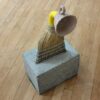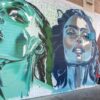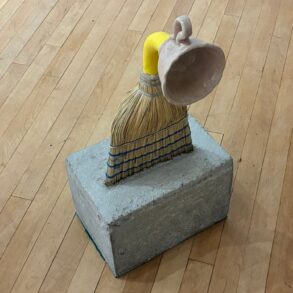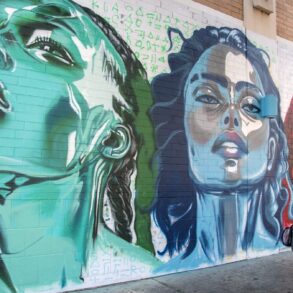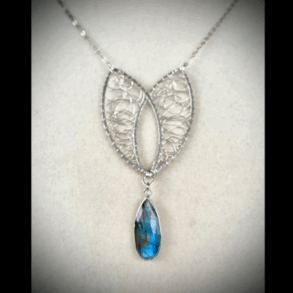The Urban Redevelopment Authority (URA) issued an order to amend a mural in Chinatown, which depicts a samsui woman seated on a chair holding a lit cigarette.
The roughly three-storey-tall mural, located on the exterior of a conserved shophouse on 297 South Bridge Road, has been up for more than two months.
It was designed by Sean P Dunston, 50, a multi-disciplinary artist from the United States, who has been based in Singapore since 2009.
The work of street art has come under the spotlight after Dunston took to Instagram on Jun. 19 to make known the discussions happening behind the scenes.
The post has been liked more than 2,400 times.
Approval not sought before mural worked on
The mural was put up on Apr. 5, 2024, before approval was sought from URA.
According to URA, all proposals for murals on conserved buildings must be submitted to both the building owner and URA for approval before works are carried out.
A proposal was submitted on Apr. 19, upon URA’s request, The Straits Times reported.
URA then requested a resubmission of the proposal on May 8, with a deadline on May 22.
The request for a resubmission concerned the cigarette in the mural, which URA said was “not aligned with Singapore’s anti-smoking policy stance”.
Dunston also told Mothership that there was some discussion between his client, who commissioned the mural, and URA regarding the cigarette.
The artist said his client wanted to keep the cigarette, but URA rejected the proposal because of it.
The May 22 deadline was then not met.
URA, in a Jun. 18 email seen by Mothership, then issued an order to amend the mural.
The email took note of the lapsed deadline, as well as included feedback from a member of the public who felt the mural was “offensive”.
Woman looks more like a “prostitute”
Dunston said he wanted to portray the “spirit, strength, beauty and attitude of the samsui women” through his mural, according to his submitted proposal to URA.
The cigarette was meant to signal a moment of repose.
The woman can also be seen holding in her left hand a Taoist talisman, attached to a red thread, which Dunston said was meant to symbolise the woman’s connection to “her family and the people in her life”.
Dunston said he was attempting to “create an iconic, vivid composite of a samsui woman in her prime and in a moment of peace”.
Not everyone saw the mural the same way though.
URA, in their Jun. 18 email, cited feedback from a “member of public”, which read:
“We find this mural offensive and is disrespectful to our samsui women. The woman depicted in this mural looks more like a prostitute than a hardworking samsui woman.”
According to Dunston, URA requested that the mural be adjusted such that the samsui woman does not look “like a prostitute”.
When asked how he plans on amending the mural, Dunston told Mothership: “Still working on it. I need to try to figure out a way to amend it so that she ‘doesn’t look like a prostitute’.”
Enforcement action
URA also stated in their Jun. 18 email that Dunston has till Jul. 3 to amend or remove the mural according to their advice, failing which, the building’s temporary permit for a restaurant “will be taken into consideration for any application for the renewal”.
Ya Kun Kaya Toast, whose Temporary Permission expires on Jul. 27, is the restaurant.
URA added that “should the Temporary Permission not be renewed, the use of the premises as a ‘Restaurant’ shall cease accordingly”.
URA response
In response to Mothership‘s queries on Jun. 21, URA said via a spokesperson:
All proposals for murals on conserved buildings must be submitted to both the building owner and URA for approval before works are carried out. The mural on the conserved shophouse at 297 South Bridge Road was completed without prior approval and URA had informed the building owner to submit the mural proposal for assessment. Following consultation with local stakeholders and relevant agencies, the proposal was not supported as the depiction of smoking on the unauthorised mural is not aligned with Singapore’s anti-smoking policy.
In light of recent public feedback, URA is re-evaluating its stance on the mural.
How do we remember the samsui women?
Samsui women, also known as “Hong Tou Jin” (literally “red headscarf”), were migrants from Southern China — in particular the Samsui area of Guangdong — to Singapore in the early 20th century.
They were manual labourers, and are frequently identified by their oblong red cloth headgear, black tunic and black pants, though not all samsui women dressed or looked the same.
Life as a samsui woman was gruelling.
According to the National Library Board, their day typically began at 8am and would end at 5pm or 6pm.
They would then relax by smoking cigarettes before going to bed.
As historian Kelvin Low noted, this curated memory of samsui women has taken on numerous significances throughout the years.
For some, the samsui women have become a source of nostalgia.
For others, they are seen as “pioneers” and early figures of “feminism”.
Such nostalgic, romanticised depictions of the samsui women, Low argues, come at the risk of erasing the gritty realities and complexities of their actual lives.
According to Dunston, samsui women are “usually depicted on task, or in less than comfortable contexts, and much older”, though he claimed that “they were often as young as any other workers” at the time they were here.
Dunston also said he looked at historical reference photos of samsui women, and saw that the photos were “candid, slice of life, and impersonal”.
Top photo from seanpdunston/Instagram.
This post was originally published on this site be sure to check out more of their content

